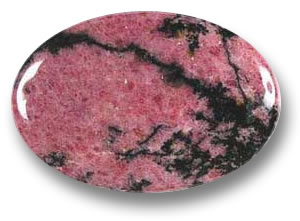The Gemstone Rhodonite

Rhodonite is an inexpensive pink gemstone. It
often has impurities of black manganese oxide dendrite veins running through it, creating interesting formations and providing a nice contrast. The name Rhodonite is derived from the term rhodos, which is Greek for "Rose colored".
Chemical Formula
?
MnSiO
3
Mineral Class
?
Rhodonite
All About
When used as a gemstone, Rhodonite is almost always opaque. A rare form of transparent
gemmy Rhodonite is occasionally faceted as a gemstone, creating a deeply colored beautiful gemstone. This form of Rhodonite is relatively soft for a gemstone, and being highly valued by mineral collectors, it retains its value in its natual form. Thus, such stones are rarely cut, but when they are they command very high prices.
Rhodonite was used as an important carving stone in Russia, with classic ornamental pillars, serving bowls, tiles, and sculptures made from Rhodonite for Russian aristocrats, especially the Russian czars.
Uses
?
Rhodonite is polished into beads and cabochons, and is used in necklaces, bracelets, and pendants. It is occasionally carved into ornamental objects, ornate tiles, and small statues. The deep pink to red transparent forms are occasionally faceted as rare gemstones.
Treatments & Enhancements
?
Rhodonite gemstones are generally not treated or enhanced, although they may be occassionally waxed to enhance luster.
Rhodonite Sources
?
Sources of gem Rhodonite are Russia, Australia, Japan, Madagascar, Sweden, Brazil, and Peru. Rhodonite also comes from the U.S. at New Jersey and Massachusetts.
Similar Gemstones
?
Rhodochrosite is much softer and usually contains white banding, and
Thulite lacks the black manganese oxide
dendrites and
inclusions.